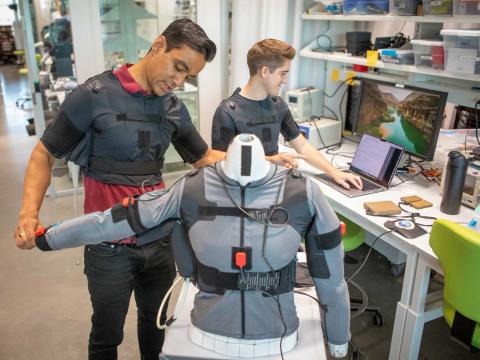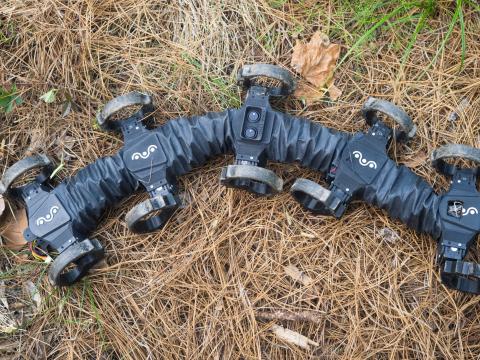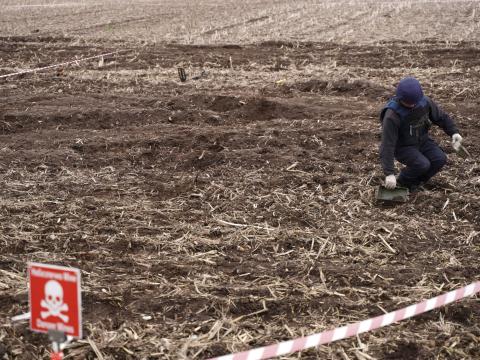U.S. Robots Surge Onto the Battlefield
 |
| One of the 20 platforms managed by the Robotic Systems Joint Project Office (RSJPO), the Throwbot reconnaissance robot weighs less than a pound and is the size of a soda can. Designed to be tossed into windows and through doorways, and equipped with a video camera, the system is controlled by a handheld unit to scout ahead for booby traps and ambushes in urban operations. |
Unmanned ground systems have become a vital tool for warfighters operating in
The organization responsible for managing, sustaining and maintaining these unmanned platforms is the Robotic Systems Joint Project Office (RSJPO),
The RSJPO’s mission is to provide warfighters with robot systems by pushing new technologies out to troops as soon as the technologies are available. A key mission for operations in
As the designated agency for acquiring, fielding, training and sustaining robotic systems for the Army and the Marine Corps, the RSJPO coordinates with the other services and participates in joint robotics efforts through the Office of the Secretary of Defense (OSD). Gotvald notes that the office meets with the OSD twice a year to propose robotics efforts including collaboration tests and systems fielding.
Army and Marine Corps research laboratories also are tied to the RSJPO and must obtain the office’s endorsement for individual research and development programs before they can request funding. Gotvald explains that the program office must agree to an acquisition plan before funding for new research is released. “There must be a plan in place to put it [the system] in the field and to produce, train, field and sustain it,” he says.
This service-supported research can involve developing an entire system or specific payloads such as a sensor. Besides working with other U.S. Defense Department agencies, the RSJPO also works closely with university and industry research teams. Gotvald shares that office personnel attend robotics industry events sponsored by organizations such as the Association for Unmanned Vehicle Systems International to stay abreast of new technology developments. But the office’s core mission is acquiring, managing and supporting the unmanned platforms used by the services.
Approximately 20 types of robotic systems are now in use in
One robotic system now being readied for deployment is the Throwbot, a tactical robot that can be tossed into doorways and windows. The small, cylindrical robot is about the size of a soda can, has two wheels and a video camera, and weighs less than half a pound. Developed by ReconRobotics Inc.,
Another platform entering service is the Gladiator. Developed by
 |
| The RSJPO is currently evaluating the Gladiator unmanned ground system. Developed for the Marine Corps by Carnegie Mellon University, Gladiator is a multipurpose robot intended to support combat operations. The capability also can be equipped with machine guns or grenade launchers. |
In 2004 the Defense Department requested 162 robotic systems from the RSJPO. Initially classified, this request was to provide robots to support operations in
The RSJPO also recently acquired a new robotic system, the xBot. Manufactured by iRobot Corporation,
The xBots are part of a “robotic surge” designed to support stepped-up operations in
Other robotic systems on the horizon are the unmanned ground components of the Army’s Future Combat Systems (FCS) program. As the initial phases of the FCS program are spiraled into the current force (SIGNAL Magazine, November 2007), the Small Unmanned Ground Vehicle (SUGV) Block 1 platform will be deployed to Army units. Gotvald says that the office is currently evaluating the SUGV with the goal of deploying more of this particular platform. This combination of in-theater robots and evaluation systems is greatly expanding the number of robots under RSJPO management. “By the end of the year, we could easily have over 6,000 systems,” he says.
Robots in the field are managed and maintained by the office’s Joint Robotics Repair Facility, a 30,000-square-foot center consisting of warehouses, offices and technical workshops. More than 100 Army and Marine Corps Reserve personnel staff the facility. The RSJPO also maintains repair centers in Southwest Asia, including a 15,000-square-foot repair facility in
When a deployed robot is damaged or requires maintenance, Army and Marine Corps units can take the machine to an RSJPO facility, where it is either repaired or replaced within four hours. To manage and track rapid repair and servicing, the office has an elaborate contracting framework in place backed by a computerized database and parts tracking system.
Besides explosives and combat damage, another major challenge to robot operations in the region is the crowded electromagnetic environment. Because most robotic systems must be operated remotely via wireless links, their control systems are susceptible to interference from other communications or jamming systems designed to jam IEDs. Gotvald adds that another technical challenge is maintaining non-line-of-sight communications without disrupting command and control links.
Because new technologies can offer solutions to the operational challenges faced by battlefield robots, the RSJPO maintains close relationships with other
Another responsibility of the RSJPO is assisting the Training and Doctrine Command (TRADOC) in developing new doctrines for robotic platforms. Gotvald says that the office’s training efforts focus on system capabilities primarily rather than mission doctrine. RSJPO personnel are posted at TRADOC’s schools to help develop the doctrine, but he says that the office does not create its own doctrine.
Besides maintaining robotic systems for the Army and Marine Corps, the RSJPO also provides repair and maintenance support for the other services’ robots, especially those used for explosive ordnance disposal. Gotvald adds that the U.S. Navy and Air Force operate their own counter IED robots in
Web Resources
Robotic Systems Joint Project Office: www.redstone.army.mil/ugvsjpo
Association for Unmanned Vehicle Systems International: www.auvsi.org
ReconRobotics Inc.: www.recon-scout.com
Carnegie Mellon Robotics Institute: www.ri.cmu.edu




Comments